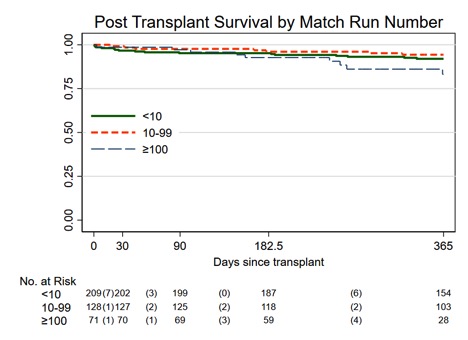Impact of UNOS Acceptance Sequence Number on Liver Graft Survival
University of Arizona/Banner University Medical Center Phoenix, Phoenix, AZ
Meeting: 2020 American Transplant Congress
Abstract number: LB-016
Keywords: Allocation, Liver grafts, Outcome
Session Information
Session Name: Poster Session B: Late Breaking
Session Type: Poster Session
Date: Saturday, May 30, 2020
Session Time: 3:15pm-4:00pm
 Presentation Time: 3:30pm-4:00pm
Presentation Time: 3:30pm-4:00pm
Location: Virtual
*Purpose: Many initially declined liver grafts will go on to be successfully transplanted into other candidates. Limited information exists regarding outcomes of liver grafts that have been previously declined by numerous centers. This study was designed to evaluate the impact of the UNOS acceptance sequence number (ASN) on graft survival.
*Methods: Included were all consecutive, primary liver transplant recipients between August 1, 2014 and October 31, 2019 at a single center (n = 408). Patients were stratified by their UNOS ASN into three categories: <10, 10-99, and ≥100. Primary endpoints were graft failure and mortality at 1-year post-transplantation. Kaplan-Meier curves with log-rank tests were performed to compare survival amongst groups. Univariate and multivariate Cox proportional hazards models were used to evaluate the effect of multiple factors on survival.
*Results: Of the 408 patients included in this study, stratification based on UNOS ASN resulted in the following distribution: <10 (n=209, 51%), 10-99 (n=128, 31%), and ≥100 (n=71, 17%). Recipient MELD scores at transplant varied predictably amongst the three groups, with ASN <10 at 35 ± 10.7, ASN 10-99 at 19 ± 9.4 (p < 0.0001), and ASN ≥100 at 15 ± 7.4 (p < 0.0001). Compared to the reference group of ASN <10, notable significant differences in recipient characteristics included gender, age, HCV status, HCC, and hepatopulmonary syndrome. Donor characteristics of age, BMI, DCD donor distribution, terminal AST/ALT/sodium labs, and local procurement DSA were also statistically significantly different. Graft failure during the first year post-transplantation occurred in the following distributions: <10 (n = 10, 5%), 10-99 (n = 12, 9%; p = 0.10), ≥100 (n = 3, 4%; p = 0.85). No significant difference in 1-year patient survival was observed regardless of group stratification, Figure 1. The log-rank test of these survival curves was not statistically significant (p = 0.10). In a multivariate Cox proportional hazards model, ASN 10-99 showed non-significant 0.74 times reduced risk of death (95% CI 0.28-1.97, p = 0.543) while ASN ≥100 showed a non-significant 2.70 times increased risk of death over the <10 group (95% CI 0.97-7.48, p = 0.057). This model controlled for MELD score at transplant, total surgical time in hours, and depression.
*Conclusions: Preliminary results suggest that the UNOS ASN has no statistically significant impact on 1-year patient survival.
To cite this abstract in AMA style:
Thornley C, Kezirian O, Mehta S, Cashman J, Brink J, Jr TChaly, Werf WVander. Impact of UNOS Acceptance Sequence Number on Liver Graft Survival [abstract]. Am J Transplant. 2020; 20 (suppl 3). https://atcmeetingabstracts.com/abstract/impact-of-unos-acceptance-sequence-number-on-liver-graft-survival/. Accessed December 21, 2025.« Back to 2020 American Transplant Congress

